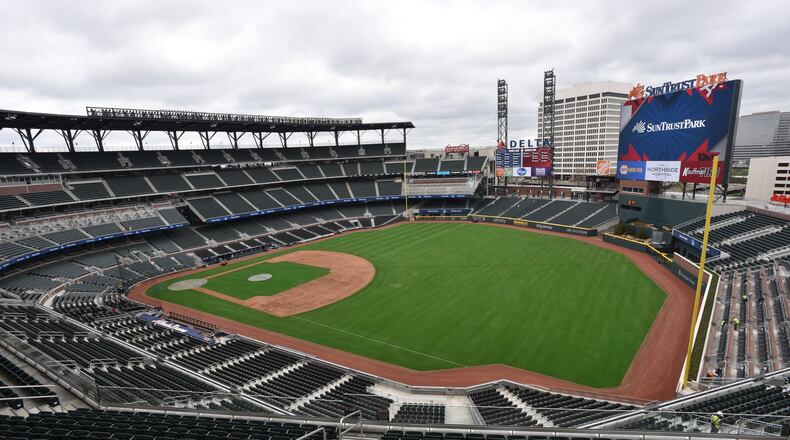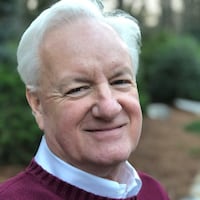Hank Aaron recently glanced around SunTrust Park and smiled.
“It looks like a good ballpark to hit in,” he said.
As the Braves open their new stadium Friday night, many fans — and players — will assess: Is it a hitter's park or a pitcher's park?
Atlanta-Fulton County Stadium, the Braves’ home from 1966 through 1996, was such a good hitter’s park that it became known as The Launching Pad.
And conversely, Turner Field, the Braves’ home from 1997 through 2016, was a pitcher-friendly park.
It will take some time for a definitive judgment on whether SunTrust Park significantly favors hitters or pitchers. Some early indications suggest hitters will like it.
“I think we’re going to have to let a year play out and see,” said Braves Vice Chairman John Schuerholz, who was involved in determining the ballpark dimensions. “But at the end of the year I don’t think it’s going to measure as dramatically benefiting hitters or pitchers. I think we’re going to find it to be a pretty balanced place.”
Schuerholz acknowledged the Braves deliberately designed Turner Field to slightly favor pitchers, the team’s strength at the time The Ted was built. They set out to make SunTrust Park “a little more on balance, if you will,” favoring neither pitchers nor hitters, he said.
But even that balance, if achieved, would make it better for hitters than Turner Field.
“I think so,” Braves manager Brian Snitker said. “That is kind of what we were told in the beginning.”
The biggest change in dimensions is the distance to the wall in the right-field power alley — 375 feet at SunTrust Park compared with 390 feet at Turner Field.
Asked his favorite feature of the new stadium, Braves first baseman Freddie Freeman said simply: “375 to right-center.”
SunTrust Park counters that gift to left-handed hitters, however, with a taller right-field wall — 16 feet high, roughly twice as high as at Turner Field.
So batters won’t have to hit the ball as far for a home run to right-center, but they will have to hit it higher.
On average, ESPN’s Park Factors analysis ranked Turner Field as MLB’s 14th best stadium for pitchers from 2001 through last season, although the ranking varied considerably by season. The calculations scored The Ted as pitcher-friendly in 10 of those 16 seasons.
Other than right-center field, SunTrust Park’s dimensions are similar to Turner Field’s: 335 feet down the left-field line (unchanged), 385 feet in the left-field power alley (compared with 380 at Turner), 400 feet to straight-away center field (unchanged) and 325 feet down the right-field line (compared with 330 at Turner).
“I don’t think the dimensions are dramatically to the benefit of hitters,” Schuerholz said. “Nor do I think they are to the benefit of pitchers.”
He said, however, that the wind and how the ball carries could be more telling than the dimensions in determining how SunTrust Park plays.
The Braves’ March 31 exhibition game in the stadium and their March 30-31 batting practice sessions there gave reason to wonder if the ballpark will be more hitter-friendly than perhaps intended.
“In the exhibition game against the Yankees, the ball was carrying very well. Very well,” Schuerholz said. “I don’t know if that’s seasonal. I don’t know if that happens to be the impact of the unfinished (surrounding) buildings, or what.”
Eight days after the Braves-Yankees exhibition, Georgia played Missouri in a college game in the stadium. Based on what he saw that day, Georgia coach Scott Stricklin is unsure whether the park will be hitter-friendly.
“It didn’t really show,” Stricklin said. “Sometimes in parks, the wind is blowing out, but there is so much swirl within the stadium. It seemed like it played a little big, for the most part. In batting practice, it played kind of big. It didn’t see a lot of balls flying out of the park.”
The Braves consulted years of wind studies from the nearby Dobbins Air Reserve Base in designing the stadium.
In general, the studies suggested the wind would blow out more than it would blow in and that cross-winds would favor balls hit to left field more than those hit to right. But the patterns varied by month, suggesting the park might play better for hitters early in the season and better for pitchers late in the season.
“The wind was seasonal,” Schuerholz said.
And the Braves tempered their analysis of the studies with the realization that the stadium structure and the new construction beyond the outfield, especially the Omni hotel and the Comcast office building, could change the patterns within the ballpark.
“Even though we did wind studies at Dobbins, we didn’t know what was going to happen when those buildings went up, whether they would impact the direction and the velocity of the wind, whether it would swirl,” Schuerholz said. “We’re just going to have to feel our way through it.”
The outfield wall, which was eight feet and four inches high all the way around at Turner Field, varies at SunTrust Park: six feet high in the left-field corner; eight feet, eight inches high in the left-field power alley and center field; 16 feet high in right field.
Another aspect of the new stadium that will benefit hitters is the reduced amount of foul territory. That means some foul pop-ups that would have been caught for outs at Turner Field will go into the stands, giving the batter another swing.
But there’s another key variable that ultimately will help determine whether SunTrust Park becomes known as a hitter’s park: Braves pitchers.
After all, even Atlanta-Fulton County Stadium lost its reputation as The Launching Pad when the Braves put three future Hall of Famers in their starting rotation in the 1990s.
OUTFIELD DISTANCES
Location / SunTrust Park / Turner Field
Left-field line / 335 / 335
Left-field power alley / 385 / 380
Center field / 400 / 400
Right-field power alley / 375 / 390
Right-field line / 325 / 330
Note: At Turner Field, the outfield wall was 8 feet, 4 inches high all the way around. At SunTrust Park, it varies from 6 feet high in the left-field corner to 16 feet high in right field.
ALL ABOUT SUNTRUST PARK
The AJC has been covering various aspects of SunTrust Park all week:
Tuesday*:Technology at the ballpark.
Wednesday*:"Social gathering spaces" vs. traditional seats. Also, how the stadium got its name.
Thursday*:How will new ballpark affect attendance?
Today: Hitter's park or pitcher's park?
Saturday: What will stadium and adjoining development mean for Braves' payroll and on-field competitiveness?
* - Can be read on MyAJC.com
About the Author




